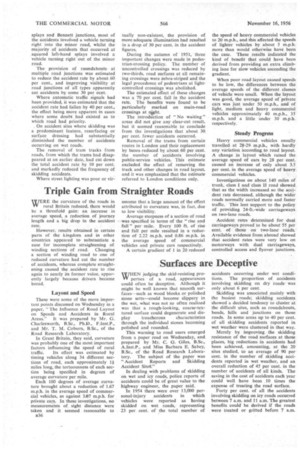Triple Gain from Straighter Roads
Page 70

If you've noticed an error in this article please click here to report it so we can fix it.
WERE the curvature of the roads in rural Britain reduced, there would be a threefold gain: an increase in average speed, a reduction of journey length and a big drop in the accident rate.
However, results obtained in certain parts of the kingdom and in other countries appeared to substantiate a case for incomplete straightening of winding sections of road. Changing a section of winding road to one of reduced curvature had cut the number of accidents, whereas complete straightening caused the accident rate to rise again to nearly its former value, apparently largely because drivers became bored.
Layout and Speed
These were some of the more important points discussed on Wednesday in a paper, "The Influence of Road Layout on Speeds and Accidents in Rural Areas." It was prepared by Mr. G. Charlesworth, B.Sc., Ph.D., F.Inst.P., and Mr. T. M. Coburn, B.Sc„ of the Road Research Laboratory.
In Great Britain, they said, curvature was probably one of the most important factors influencing the speed of rural traffic. Its effect was estimated by timing vehicles along 34 different sections of road, each approximately 11 miles long, the tortuousness of each section being specified in degrees of average curvature per mile.
Each 100 degrees of average curvature brought about a reduction of 1.67 m.p.h. in the average speed of commercial vehicles, as against 3.07 m.p.h. for private cars. In these investigations, no measurements of sight distance were taken and it seemed reasonable to B36 assume that a large amount of the effect attributed to curvature was, in fact, due to low visibility.
Average steepness of a section of road was specified in terms of the " rise and fall" per mile. Every 100 ft. of rise and fall per mile resulted in a reduction of 2.22 m.p.h. and 0.86 m.p.h. in the average speed of commercial vehicles and private cars respectively.
A certain gradient of 1 in 20 reduced the speed of heavy commercial vehicles to 20 m.p.h„ and this affected the speeds of lighter vehicles by about 5 m.p.h. more than would otherwise have been the case. These results indicated the kind of benefit that could have been derived from providing an extra climbing lane for slow vehicles ascending the gradient.
When poor road layout caused speeds to be low, the differences between the average speeds of the different classes of vehicle were small. When the layout was good, the average speed of private cars was just under 50 m.p.h., and of light, medium and heavy commercial vehicles approximately 40 m.p.h., 35 m.p.h. and a little under 30 m.p.h. respectively.
Steady Progress
Heavy commercial vehicles usually travelled at 28-29 m.p.h., with hardly any variation according to road layout. A change in layout which raised the average speed of cars by 28 per cent. caused an increase of only about 3.5 per cent, in the average speed of heavy commercial vehicles.
Investigations on about 140 miles of trunk, class 1 and class II road showed that as the width increased so the accident rate decreased, although the wider roads normally carried more and faster traffic. This lent support to the policy of providing 24-ft.-wide carriageways on two-lane roads.
Accident rates determined for dual carriageways proved to be about 55 per cent. of those on two-lane roads. Available evidence from abroad showed that accident rates were very low on motorways with dual carriageways, controlled access and flyover junctions.




















































































































